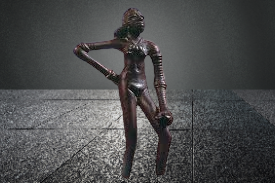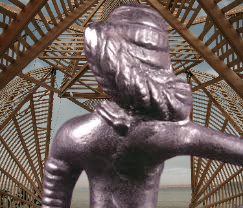Dancing Girl of Mohenjo Daro Indus Civilization is written by the Artist Zonish Tanveer
The fascinating sculpture, known as “The Dancing Girl”, is the highest achievement of modern artists. The researcher critically analyzes the bronze sculpture belonging to the Indus Civilization.
The researcher has depicted, through this artifact the idea of cultural and social norms of the society during that age. The Indus people highlighted the aesthetic beauty and conceptualization of females at that time.
Introduction: Indus Civilization
- Mohenjo-Daro, meaning;
‘Mound of the Dead Men’,
- Located In the province of Sindh, Pakistan,
“An archaeological site.“
- Built around 2500 BCE.
- One of the largest settlements of the ancient Indus Civilization.
- It is also one of the world’s earliest major cities.
- Contemporaneous with the civilizations of:
- Ancient Egypt
- Mesopotamia
- Minoan Crete
- Mohenjo-Daro was abandoned in the 19th century BCE as;
- The Indus Civilization declined
- The site was not rediscovered until the 1920s.”
- At the site of the city, significant excavation has since been conducted.
- At its height, the Indus Civilization spanned much of what is now Pakistan and North India.
- It extended westwards to the:
- Iranian border
- South to Gujarat in India
- Northwards to Bactria
Indus Civilization: Historical Context of Mohenjo-Daro
- Mohenjo-Daro was a cornerstone of the Indus Civilization;
- Spanned regions of modern-day Pakistan and northwestern India.
- Its strategic location and sophisticated urban planning made it;
“A beacon of ancient innovation.”
- The sculpture (made about 2500 BC) was discovered by Indian archaeologist D. R. Sahni (1879-1939)
- He discovered it during his 1926-1927 field season at the site in the;
- Remains of a modest house
- The southwestern sector of Mohenjo Daro
Indus Civilization Artistic and Cultural Significance
- Mohenjo-Daro was abandoned in the 19th century BCE as;
- The Indus Valley Civilization declined
- The site was not rediscovered until the 1920s
- Significant excavation has since been conducted at the site of the city.
- At its height, the Indus Civilization spanned much of what is now Pakistan and North India.
- It extended westwards to the Iranian border, south to Gujarat in India, and northwards to Bactria.
- The sculpture, which stands 10.8 centimeters (4.25 inches) tall and is made of:
- Copper
- Bronze
- It has been dubbed;
“The Dancing Girl of Mohenjo-Daro by generations of enamored archaeologists.”
- The Dancing Girl figurine was created using the:
- Lost wax (cire perdue) technique
- It includes creating a mold and pouring molten metal.
Anatomy of the Dancing Girl

The statue is a free-standing;
- Naturalistic sculpture of a naked lady.
- In left arm, she has a stack of 25 bangles.
- Four bangles on her right arm, two at the wrist and two above the elbow;
- The hand is on her hip
- The arm is bent at the elbow.
- The head is leaned slightly backward.
- The left leg is bowed at the knee.
- Arms and legs are noticeably longer than the body.
- She has her hair up in a loose bun
Spirally coiled and pinned at the back of her head.
- She is wearing a necklace with three huge pendants.
- Several academics contend that;
“The statuette of the Dancing Girl depicts a real woman.”
Expert Opinions and Interpretations
In 1973, British archaeologist Mortimer Wheeler described the item as his favorite statuette
“There is her little Balochi-style face with pouting lips and an insolent look in her eyes. She’s about fifteen years old I should think, not more, but she stands there with bangles up her arm and nothing else on. A girl perfectly, for the moment, perfectly confident of herself and the world. There’s nothing like her, I think, in the world.”
John Marshall, another archeologist at Mohenjo-Daro, described the figure
“A young girl, her hand on her hip in a half-impudent posture, and legs slightly forward as she beats time to the music with her legs and feet.”
The archaeologist Gregory Possehl said of the statuette,
“We may not be certain that she was a dancer, but she was good at what she did, and she knew it”.
Broader Implications
The significance of “The Dancing Girl” extends beyond its artistic value. As one of the few copper-bronze sculptures of the Harappan era, it showcases the Indus Civilization’s technological and material advancements. The use of alloys such as bronze and the application of the lost wax technique highlight a level of sophistication unparalleled in many contemporary cultures.
Thousands of figurines have been found at Harappan sites, including over 2,500 at Harappa alone, although most of them are terracotta, which is formed of burnt clay. Just a small number of Harappan sculptures are made of stone (like the well-known priest-king figure) or of lost-wax copper bronze (like the dancing lady).[1]
The Metallurgical Excellence of the Indus Civilization
Research indicates that the Harappan people mastered various metalworking techniques, blending copper alloys with tin, arsenic, and other elements to create durable and versatile materials. Studies by Hoffman and Miller (2014) reveal that while the majority of copper-based objects were utilitarian, figurines like “The Dancing Girl” exemplify the civilization’s artistic endeavors. The bronze figurine not only reflects technological innovation but also the social and cultural dimensions of its creators.
Figurines as Cultural Artifacts
Harappan figurines, including “The Dancing Girl,” served as more than decorative pieces.
Figurines are a complex category of representational artifacts that can be found in numerous ancient and contemporary human communities. Figurines of people and animals can illuminate social identity ideas such as sex, gender, sexuality, and others. Such a realization is crucial for us now because many prehistoric societies had no written language that could be read. the fact Despite that the Harappans had a written language, no modern academic has yet been able to translate the Indus Script.
According to a recent study on the use of copper-based metals in Indus civilization sites (Hoffman and Miller 2014), the majority of classic Harappan-era objects made of copper-bronze are vessels (jars, pots, bowls, dishes, pans, scale pans), tools (blades from sheet copper; chisels, pointed tools, axes and adzes); and ornaments (bangles, rings, beads, and decorative-headed pins) by casting. Hoffman and Miller discovered that compared to these other artifact kinds, copper mirrors, figurines, tablets, and tokens are comparatively uncommon. Stone and ceramic tablets are much more prevalent than bronze tablets with a copper base.
The Harappans used a range of mixtures to create their bronze objects, including copper alloys with tin and arsenic as well as smaller amounts of zinc, lead, Sulphur, iron, and nickel. The Harappans produced some of the first brass on our planet, which is made when copper and zinc are combined to create brass rather than bronze. Researchers Park and Shinde (2014) contend that manufacturing needs and the fact that pre-alloyed and pure copper were traded into the Harappan towns rather than produced were the causes of the range of blends utilized in various items.
The object was carved out of wax and then covered in wet clay using the lost wax technique utilized by Harappan metallurgists. After the clay had cured, the mold had holes drilled into it, which were heated to melt the wax. Then a melted copper and tin mixture was poured into the empty mold. The copper-bronze object was then revealed when the mold was broken after it had cooled.
Unanswered Questions and Continuing Mysteries
The ethnicity of the woman depicted in the figure has been a somewhat controversial subject over the years since the figurine was discovered. Several scholars such as ECL During Casper have suggested that the lady looks African. Recent evidence for Bronze Age trade contact with Africa has been found at Chanhu-Dara, another Harappan Bronze Age site, in the form of pearl millet, which was domesticated in Africa about 5,000 years ago. There is also at least one burial of an African woman at Chanhu-Dara, and it is not impossible that the Dancing Girl was a portrait of a woman from Africa.
However, the figurine’s hairdressing is a style worn by Indian women today and in the past, and her armful of bangles is like a style worn by contemporary Kutchi Rabari tribal women. British Archaeologist Mortimer Wheeler, one of many scholars besotted by the statuette, recognized her as a woman from the Baluchi region.
Indus Civilization: Conclusion
The statue shows two important discoveries about the civilization: first that they knew metal blending, casting, and other civilized methods, and secondly, that entertainment, especially dance, was part of the culture. The Indus people had a good sense of fashion. The statue indicates the status of women which is being confident, having skill in dance and music, etc. Through this
sculpture the author has concluded that the true piece of art is the result of genuine motivation and inspiration and such pieces of sculpture like the dancing girl and its impact taste forever.







